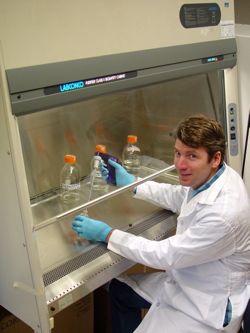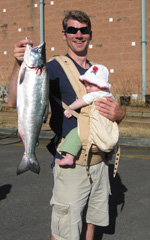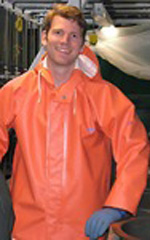New faculty member studies processes behind aquatic diseases
Ultimate goal is to better manage farmed and wild stocks to reduce disease burdens
Most people try to avoid infectious diseases. Dr. Andrew Wargo seeks them out.
Wargo, a newly hired professor at William & Mary’s Virginia Institute of Marine Science, studies the ecology of parasites, viruses, and other pathogens, and the mutual evolution between these organisms and their hosts.
Host-pathogen interactions are at the heart of a number of Chesapeake Bay’s most pressing marine-life issues, including the Dermo and MSX diseases that have devastated native oyster populations.
 “I tackle broad questions related to pathogen ecology and evolution that apply across systems,” says Wargo, “and I’m eager to begin exploring local systems. Truth be told, there are so many great questions it’s hard to know where to start.”
“I tackle broad questions related to pathogen ecology and evolution that apply across systems,” says Wargo, “and I’m eager to begin exploring local systems. Truth be told, there are so many great questions it’s hard to know where to start.”
Professor Jeff Shields, one of Wargo’s new colleagues, says "Andrew brings a strong suit of cutting-edge skills to the institute. His excellence in virology and his general interests in microbiology and disease ecology provide us with expertise to address emerging issues in aquaculture, fisheries, and conservation ecology."
Wargo’s interest in infectious diseases began during his undergraduate career at the University of Vermont. “I was originally interested in becoming a herpetologist, so I joined a lab studying lizard malaria,” he says. “I quickly discovered that parasites were just as cool —if not more cool—than lizards. I was hooked from there on out.”
Wargo continued to study malaria—a mosquito-borne parasite that infects more than 200 million people annually—during his doctoral studies at the University of Edinburgh in Scotland. He published papers on the in-host ecology and transmission of the parasite in the Proceedings of the Royal Society of London, the Proceedings of the National Academy of Sciences of the United States of America, and other prestigious journals.
Wargo’s shift to diseases of aquatic organisms took place when he began a post-doctoral fellowship with Professor Gael Kurath at the University of Washington. “Gael was working on the salmon virus IHNV,” says Wargo. “The biology of her system was really fascinating, and I thought it would be a great system to explore questions regarding the evolution of pathogen virulence. I've been working on fish viruses and other parasites of aquatic hosts ever since.”
“Aquatic hosts make excellent experimental systems compared to their mammalian counterparts, so they’re perfect for studying the types of questions I’m interested in,” Wargo adds. “VIMS is well known for studies of aquatic pathogens and host systems and thus is a perfect fit for my academic interest. It was very opportunistic that pathogen ecology and evolution was an area VIMS was hoping to expand into."
VIMS Professor Kim Reece, chair of the Environmental and Aquatic Animal Health Department of which Wargo is now part, agrees. “Andrew provides VIMS with a fresh new perspective on disease processes, ecology, and pathogen evolution,” she says. “His research focus, exemplary track record, and collaborative spirit were all reasons that he was selected for the position.”
As a new faculty member, Wargo’s current focus is to procure grant funding to support his research and future graduate students. He has already submitted five grant proposals to the U.S. Department of Agriculture and the National Science Foundation in collaboration with VIMS colleagues, and is now awaiting word on how the submissions have fared in these highly competitive programs.
Wargo’s research proposals focus on issues of significant local concern. A collaborative proposal with Shields lays out a plan to further study the ecology and evolution of Hematodinium, a blue-crab parasite that first struck Virginia in the early 1990s. During Hematodinium outbreaks, crab mortality can reach 50% in crab pots, and 75% in shedding facilities for soft-shell crabs on Virginia’s Eastern Shore.
A pair of proposals submitted with VIMS associate professor Ryan Carnegie look to study the evolution of virulence, or disease severity, in oysters infected by Perkinsus. This is the parasite that causes Dermo disease, a continuing impediment to restoration of Chesapeake Bay’s oyster populations.
As he ramps up his research program at VIMS, Wargo continues to study two significant diseases of salmon and trout—infectious hematopoietic necrosis virus, or IHNV, and bacterial cold-water disease (BCWD).
“IHNV is a major issue worldwide,” says Wargo, “and has had a big impact on fish hatcheries and farms in Washington and Oregon. It offers an excellent model system to ask questions related to general pathogen ecology and evolution.”
BCWD also occurs worldwide; most frequently affecting salmon species in aquaculture settings. Wargo says “BCWD is everywhere, probably even in Virginia, although salmonid aquaculture here is small scale. I‘ve toyed with expanding into [the study of] Atlantic Salmon parasites, but that is most relevant for the Northeast and not so much the Chesapeake.”
“Ultimately,” says Wargo, “I’m an experimental evolutionary ecologist. Although I may work on salmon viruses, knowledge gained there can easily apply to oyster parasites, so in a way I use it as a model system. With that said, some local diseases also have the properties of a model system, and their own fascinating biology. Oyster parasites are a good candidate, but others may also crop up. I'm eager to tap into all the fish surveying that goes on at VIMS to get an idea of what parasites might be out there that no one has even looked at. I’m always looking for other systems and collaborators in local systems with interesting questions related to pathogen ecology and evolution."

